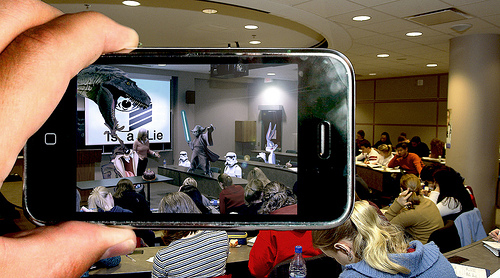The technology has been around for a while but it is only in the past couple of years that we have started to see augmented reality really come to the surface as a marketing innovation. We first saw its use about fifteen years ago when Sky Sports used a form of augmented reality to illustrate its football reports – it could show where players were and when they were offside during commentary.
Clearly technology has advanced since then and the new technology coming through from cutting edge developers can be used in a number of ways by marketers. We’ve seen certain products putting the technology to good use on their packaging. Using augmented reality really can enhance a customer’s product experience as it puts it literally in their hands. Holding their phone over a certain point on a label can give the consumer a new recipe perhaps, or invite them to ‘like’ their Facebook page. Ultimately it’s all about adding value to a product’s offering. Lego, for example, has used augmented reality technology in-store to show customers how the box of Lego that they are holding looks when put together. As shown in this video. The customer holds the box up to a screen and the image of the finished Lego model appears in front of them – it is this enhanced product experience that can increase the likelihood of a sale.
Blippar is one of the companies promoting its technology and, with Blippar, users can point their smart phone at a certain mark on a product to find out key information, ie price etc, movie promoters can use it by allowing customers to view a trailer when they are in front of a poster and it is in the outdoor space that this technology has mainly taken off so far. Jurassic Park 3D used this to simply play out the film trailer without the need to be connected over 3G or Wi-Fi.
Understanding that customers have mobiles and that they can be useful from a marketing point of view gives augmented reality a real spring board for reach and engagement but it is important to take a look at the argument against investment in it.
Firstly there is obviously a large cost involved in initially setting up the technology. The expensive development of creative ideas can be obstructive and it takes a brave client to explore its possibilities in the first place.
Secondly the fact that using augmented reality actually requires quite a big ‘ask’ of a consumer could limit its use in the immediate future. A consumer needs to download an app, understand how to use the app, read the instructions and then take the time to experience the creative execution. It is not ‘effortless’ and is therefore perhaps a risk that clients might not want to take as it offers that additional barrier to engaging with the brand.
Thirdly, augmented reality exists in different forms – as the enhancement of packaging as mentioned before when a consumer uses their smart phone to see a ‘hidden’ message which is picked up by marks. It also exists as a live event technology, for example when members of the public can interact with a ‘virtual’ image in a public space. Clearly there is more to be gained from a PR perspective by the latter but while the brand might be remembered, it is virtually impossible to measure an ROI in terms of directly-linked sales from this kind of event, even when people do enjoy seeing ‘cool’ and experimental interactive events.
The big shift in recent years which has made the use of this technology possible is the penetration of smart phone usage. It is understanding the possibilities that open up when you have customers with mobiles in their hands, and apps available to download for very little cost, that might take some time to cement in our behaviour of engaging further with brands.
While there is a low adopter point for augmented reality at the moment, it does seems to be currently more in use in certain sectors including cars, eg VW, food eg Marmite and gaming eg PS Vita. The set up costs will obviously reduce if the volume of campaigns increases and as technology improves that is inevitable, but there still needs to be a shift in how the technology appeals and to how many people.
Image credit: turkletom






